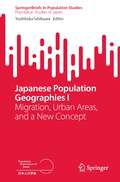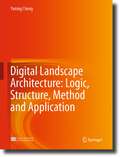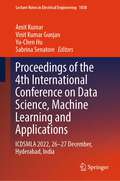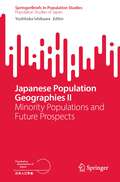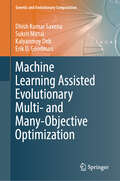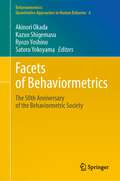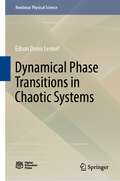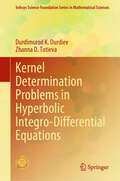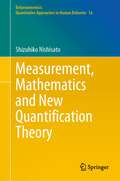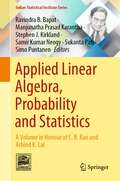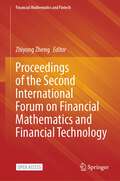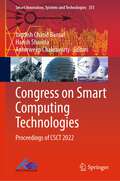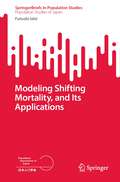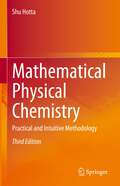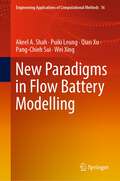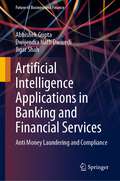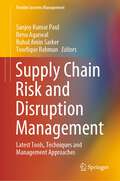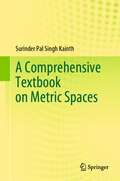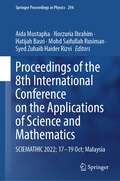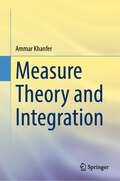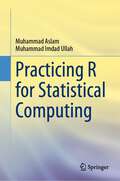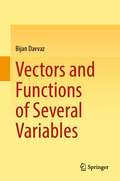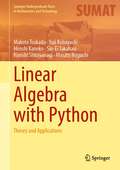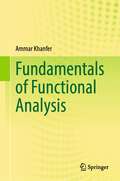- Table View
- List View
Japanese Population Geographies I: Migration, Urban Areas, and a New Concept (SpringerBriefs in Population Studies)
by Yoshitaka IshikawaThis is the first anthology that conveys in detail the actual situation of population geographies in Japan, a country facing some of the world's most serious demographic trends such as low fertility, population aging, and depopulation. The anthology consists of two volumes with the common title Japanese Population Geographies. All of the included entries are based on original Japanese papers written by leading geographers and published within the past few years, useful for understanding Japan’s current population geographies. The first volume analyzes the postwar transition of internal migration, examining the structural changes of population in urban areas, and proposes a new measure different from the traditional resident population. This volume also presents an investigation of the retirement migration of baby boomers as well as displacement migration due to the 2011 Great East Japan Earthquake. The second volume’s contents examine the residential choices of minority populations such as foreign residents and sexual minorities. It also discusses future prospects associated with mono-polar concentration into Tokyo, regional forecasting using population projections based on small-area units, and the importance of a politico–economic perspective in the future research. Taken as a whole, this anthology offers the following two significant contributions. First, the excellent achievements obtained in Japan, which is experiencing serious demographic trends, reflect key developments within the context of the world's population geography. The second contribution is that the book brings the latest insights and important policy implications to countries that are facing various issues associated with decreasing fertility, aging population, and declining population.
Digital Landscape Architecture: Logic, Structure, Method and Application
by Yuning ChengClosely related to the frontier research field of “digital technology”, this book reshapes the planning and design process of landscape architecture from theoretical and practical levels. It gives a full-scale discussion to the logic, structure, method, and application of digital landscape architecture, leading this field to a new era of perception-quantification research mode. Readers will get a comprehensive understanding of digital landscape architecture, know about multiple digital methods for landscape planning and design, and learn a lot of practical projects with digital technology. And it will inspire the readers to think about new patterns and approaches to landscape planning, rather than traditional ways. This book is organized under a clear logic, which helps the readers easily get the core of the work. A lot of logic diagrams showing between the theoretical paragraphs highly summarize the key points of the book, providing a better readability and acceptability. This book also contains many detailed drawings and graphics for the project cases, which gives a good demonstration of how digital methods could be applied in practice.
Proceedings of the 4th International Conference on Data Science, Machine Learning and Applications: ICDSMLA 2022, 26–27 December, Hyderabad, India (Lecture Notes in Electrical Engineering #1038)
by Amit Kumar Vinit Kumar Gunjan Yu-Chen Hu Sabrina SenatoreThis book includes peer reviewed articles from the 4th International Conference on Data Science, Machine Learning and Applications, 2022, held at the Hyderabad Institute of Technology & Management on 26-27th December, India. ICDSMLA is one of the most prestigious conferences conceptualized in the field of Data Science & Machine Learning offering in-depth information on the latest developments in Artificial Intelligence, Machine Learning, Soft Computing, Human Computer Interaction, and various data science & machine learning applications. It provides a platform for academicians, scientists, researchers and professionals around the world to showcase broad range of perspectives, practices, and technical expertise in these fields. It offers participants the opportunity to stay informed about the latest developments in data science and machine learning.
Japanese Population Geographies II: Minority Populations and Future Prospects (SpringerBriefs in Population Studies)
by Yoshitaka IshikawaThis is the first anthology that conveys in detail the actual situation of population geographies in Japan, a country facing some of the world's most serious demographic trends such as low fertility, population aging, and depopulation. The anthology consists of two volumes with the common title Japanese Population Geographies. All of the included entries are based on original Japanese papers written by leading geographers and published within the past few years, useful for understanding Japan’s current population geographies. The first volume analyzes the postwar transition of internal migration, examining the structural changes of population in urban areas, and proposes a new measure different from the traditional resident population. This volume also presents an investigation of the retirement migration of baby boomers as well as displacement migration due to the 2011 Great East Japan Earthquake. The second volume’s contents examine the residential choices of minority populations such as foreign residents and sexual minorities. It also discusses future prospects associated with mono-polar concentration into Tokyo, regional forecasting using population projections based on small-area units, and the importance of a politico–economic perspective in future research. Taken as a whole, this anthology offers the following two significant contributions. First, the excellent achievements obtained in Japan, which is experiencing serious demographic trends, reflect key developments within the context of the world's population geography. The second contribution is that the publication brings the latest insights and important policy implications to countries that are facing various issues associated with decreasing fertility, aging population, and declining population.
Machine Learning Assisted Evolutionary Multi- and Many- Objective Optimization (Genetic and Evolutionary Computation)
by Dhish Kumar Saxena Sukrit Mittal Kalyanmoy Deb Erik D. GoodmanThis book focuses on machine learning (ML) assisted evolutionary multi- and many-objective optimization (EMâO). EMâO algorithms, namely EMâOAs, iteratively evolve a set of solutions towards a good Pareto Front approximation. The availability of multiple solution sets over successive generations makes EMâOAs amenable to application of ML for different pursuits. Recognizing the immense potential for ML-based enhancements in the EMâO domain, this book intends to serve as an exclusive resource for both domain novices and the experienced researchers and practitioners. To achieve this goal, the book first covers the foundations of optimization, including problem and algorithm types. Then, well-structured chapters present some of the key studies on ML-based enhancements in the EMâO domain, systematically addressing important aspects. These include learning to understand the problem structure, converge better, diversify better, simultaneously converge and diversify better, and analyze the Pareto Front. In doing so, this book broadly summarizes the literature, beginning with foundational work on innovization (2003) and objective reduction (2006), and extending to the most recently proposed innovized progress operators (2021-23). It also highlights the utility of ML interventions in the search, post-optimality, and decision-making phases pertaining to the use of EMâOAs. Finally, this book shares insightful perspectives on the future potential for ML based enhancements in the EMâOA domain.To aid readers, the book includes working codes for the developed algorithms. This book will not only strengthen this emergent theme but also encourage ML researchers to develop more efficient and scalable methods that cater to the requirements of the EMâOA domain. It serves as an inspiration for further research and applications at the synergistic intersection of EMâOA and ML domains.
Facets of Behaviormetrics: The 50th Anniversary of the Behaviormetric Society (Behaviormetrics: Quantitative Approaches to Human Behavior #4)
by Akinori Okada Kazuo Shigemasu Ryozo Yoshino Satoru YokoyamaThis edited book is the first one written in English that deals comprehensively with behavior metrics. The term “behaviormetrics” comprehends the research including all sorts of quantitative approaches to disclose human behavior. Researchers in behavior metrics have developed, extended, and improved methods such as multivariate statistical analysis, survey methods, cluster analysis, machine learning, multidimensional scaling, corresponding analysis or quantification theory, network analysis, clustering, factor analysis, test theory, and related factors. In the spirit of behavior metrics, researchers applied these methods to data obtained by surveys, experiments, or websites from a diverse range of fields. The purpose of this book is twofold. One is to represent studies that display how the basic elements of behavior metrics have developed into present-day behavior metrics. The other is to represent studies performed mainly by those who would like to pioneer new fields of behavior metrics and studies that display elements of future behavior metrics. These studies consist of various characteristics such as those dealing with theoretical or conceptual subjects, the algorithm, the model, the method, and the application to a wide variety of fields. This book helps readers to understand the present and future of behavior metrics.
Dynamical Phase Transitions in Chaotic Systems (Nonlinear Physical Science)
by Edson Denis LeonelThis book discusses some scaling properties and characterizes two-phase transitions for chaotic dynamics in nonlinear systems described by mappings. The chaotic dynamics is determined by the unpredictability of the time evolution of two very close initial conditions in the phase space. It yields in an exponential divergence from each other as time passes. The chaotic diffusion is investigated, leading to a scaling invariance, a characteristic of a continuous phase transition. Two different types of transitions are considered in the book. One of them considers a transition from integrability to non-integrability observed in a two-dimensional, nonlinear, and area-preserving mapping, hence a conservative dynamics, in the variables action and angle. The other transition considers too the dynamics given by the use of nonlinear mappings and describes a suppression of the unlimited chaotic diffusion for a dissipative standard mapping and an equivalent transition in the suppression of Fermi acceleration in time-dependent billiards. This book allows the readers to understand some of the applicability of scaling theory to phase transitions and other critical dynamics commonly observed in nonlinear systems. That includes a transition from integrability to non-integrability and a transition from limited to unlimited diffusion, and that may also be applied to diffusion in energy, hence in Fermi acceleration. The latter is a hot topic investigated in billiard dynamics that led to many important publications in the last few years. It is a good reference book for senior- or graduate-level students or researchers in dynamical systems and control engineering, mathematics, physics, mechanical and electrical engineering.
Bioaerosol Characterisation, Transportation and Transmission: Fundamental, Modelling and Application
by Yihuan Yan Jiyuan TuThis book aims to predict and model the transport of bioaerosols, identify their transmission characteristics, and assess occupants’ infection risks. Although existing epidemiological books provide fundamental infection rate of existing diseases, the ability of predicting emerging disease transmission in the air and assessing occupants’ infection risks to the bioaerosols is significantly lacking. This book is considered as a professional book that provides in-depth discussion of the aforementioned issues and provides potential approaches to solve these issues would be highly demanded by readers in this emerging research field. This book offers essential and systematic analysis on the fate of bioaerosols from their release in the air to the final destination in human’s respiratory systems through direct 3D visualizations techniques. It also provides quantifiable method to assess each occupant’s infection risks to the infectious bioaerosols in indoor environments. The readers will gain essential fundamental characteristics of bioaerosols (active time, viability, etc.) and will gain the advanced skills on how to integrate these properties into numerical modeling and assess the occupants’ exposure risks.
Kernel Determination Problems in Hyperbolic Integro-Differential Equations (Infosys Science Foundation Series)
by Durdimurod K. Durdiev Zhanna D. TotievaThis book studies the construction methods for solving one-dimensional and multidimensional inverse dynamical problems for hyperbolic equations with memory. The theorems of uniqueness, stability and existence of solutions of these inverse problems are obtained. This book discusses the processes, by using generalized solutions, the spread of elastic or electromagnetic waves arising from sources of the type of pulsed directional “impacts” or “explosions”. This book presents new results in the study of local and global solvability of kernel determination problems for a half-space. It describes the problems of reconstructing the coefficients of differential equations and the convolution kernel of hyperbolic integro-differential equations by the method of Dirichlet-to-Neumann. The book will be useful for researchers and students specializing in the field of inverse problems of mathematical physics.
Measurement, Mathematics and New Quantification Theory (Behaviormetrics: Quantitative Approaches to Human Behavior #16)
by Shizuhiko NishisatoThe purpose of this book is to thoroughly prepare diverse areas of researchers in quantification theory. As is well known, quantification theory has attracted the attention of a countless number of researchers, some mathematically oriented and others not, but all of them are experts in their own disciplines. Quantifying non-quantitative (qualitative) data requires a variety of mathematical and statistical strategies, some of which are quite complicated. Unlike many books on quantification theory, the current book places more emphasis on preliminary requisites of mathematical tools than on details of quantification theory. As such, the book is primarily intended for readers whose specialty is outside mathematical sciences. The book was designed to offer non-mathematicians a variety of mathematical tools used in quantification theory in simple terms. Once all the preliminaries are fully discussed, quantification theory is then introduced in the last section as a simple application of those mathematical procedures fully discussed so far. The book opens up further frontiers of quantification theory as simple applications of basic mathematics.
Applied Linear Algebra, Probability and Statistics: A Volume in Honour of C. R. Rao and Arbind K. Lal (Indian Statistical Institute Series)
by Ravindra B. Bapat Manjunatha Prasad Karantha Stephen J. Kirkland Samir Kumar Neogy Sukanta Pati Simo PuntanenThis book focuses on research in linear algebra, statistics, matrices, graphs and their applications. Many chapters in the book feature new findings due to applications of matrix and graph methods. The book also discusses rediscoveries of the subject by using new methods. Dedicated to Prof. Calyampudi Radhakrishna Rao (C.R. Rao) who has completed 100 years of legendary life and continues to inspire us all and Prof. Arbind K. Lal who has sadly departed us too early, it has contributions from collaborators, students, colleagues and admirers of Professors Rao and Lal. With many chapters on generalized inverses, matrix analysis, matrices and graphs, applied probability and statistics, and the history of ancient mathematics, this book offers a diverse array of mathematical results, techniques and applications. The book promises to be especially rewarding for readers with an interest in the focus areas of applied linear algebra, probability and statistics.
Proceedings of the Second International Forum on Financial Mathematics and Financial Technology (Financial Mathematics and Fintech)
by Zhiyong ZhengThis open access book is the documentary of the Second International Forum on Financial Mathematics and Financial Technology, with focus on selected aspects of the current and upcoming trends in FinTech. In detail, the included scientific papers cover financial mathematics and FinTech, presenting the innovative mathematical models and state-of-the-art technologies such as deep learning, with the aim to improve the financial analysis and decision-making and enhance the quality of financial services and risk control. The variety of the papers delivers added value for both scholars and practitioners where they will find perfect integration of elegant mathematical models and up-to-date data mining technologies in financial market analysis. Due to COVID-19, the conference was held virtually on August 13–15, 2021, jointly held by the School of Mathematics of Renmin University of China, the Engineering Research Center of Financial Computing and Digital Engineering of Ministry of Education, the Statistics and Big Data Research Institute of Renmin University of China, the Blockchain Research Institute of Renmin University of China, the Zhongguancun Internet Finance Research Institute, and the Renmin University Press.
Congress on Smart Computing Technologies: Proceedings of CSCT 2022 (Smart Innovation, Systems and Technologies #351)
by Jagdish Chand Bansal Harish Sharma Antorweep ChakravortyThis book presents high-quality research papers presented at Congress on Smart Computing Technologies (CSCT 2022) organized by SAU Center for Research and Innovative Learning (SCRIL), South Asian University, India, from 3–4 December 2022. The book extensively covers recent research in algorithms for smart computing, AI and machine learning in smart computing, edge computing algorithms, adversarial networks and autoencoders, data visualization, data mining, data analytics, machine learning, game theory, high-performance computing, mobile and ubiquitous platforms for smart environments, cloud/edge/fog computing technologies for smart systems, Internet of Things (IoT) and industrial IoT technologies for smart systems, smart device and hardware, security, privacy, and economics in smart environments, big data, healthcare informatics, smart precision agriculture, smart transportation, social network analysis, and human–computer interaction.
Modeling Shifting Mortality, and Its Applications (SpringerBriefs in Population Studies)
by Futoshi IshiiThis book describes a novel method for mortality modeling applying the shifting feature of the mortality curve. In Japan, the increase and pace of the extension in life expectancy have been quite remarkable. Therefore, existing mortality models often cannot capture the peculiarities of Japanese mortality, nor can the Lee–Carter model, which is now regarded internationally as a standard model. One of the important concepts to model recent Japanese mortality is a shifting feature. In this book, the linear difference model, which has many advantages for modeling and analyzing Japanese mortality, is introduced. The book shows applications of the model to mortality projection with a tangent vector field approach and decomposition of the change of modal age at death. The models introduced here are useful tools for modeling mortality with strong shifting features, as in Japan.
Mathematical Physical Chemistry: Practical and Intuitive Methodology
by Shu HottaThe third edition of this book has been updated so that both advanced physics and advanced chemistry can be overviewed from a modern mathematical perspective in a single integrated book. Nowadays key research arears in physics and chemistry such as materials science, molecular science, and device physics are drawing closer and closer together and becoming more and more mathematical. Hence, while retaining the basic feature, the contents are targeted at graduate and undergraduate students majoring in not only chemistry but also physics and engineering. The book covers topics ranging from classical physics (e.g., electromagnetism and analytical mechanics) to quantum science. The latter topic includes an introduction to the quantum theory of fields as well as standard quantum mechanics and quantum chemistry. Tangible examples help readers to understand abstract concepts about the topics covered. Several major revisions have been made and they contain: (a) constitution of the Dirac equation; (b) quantization of the fields; (c) interaction between the quantum fields; (d) basic formalism related to the extended vector spaces and the transformation properties of the Dirac equation; (e) advanced topics of Lie algebra. The new edition thus supplies chemists, physicists, and engineers with fundamental knowledge and calculation methodology of mathematical physics.
New Paradigms in Flow Battery Modelling (Engineering Applications of Computational Methods #16)
by Akeel A. Shah Puiki Leung Qian Xu Pang-Chieh Sui Wei XingThis book provides a comprehensive review of the latest modelling developments in flow batteries, as well as some new results and insights. Flow batteries have long been considered the most flexible answer to grid scale energy storage, and modelling is a key component in their development. Recent modelling has moved beyond macroscopic methods, towards mesoscopic and smaller scales to select materials and design components. This is important for both fundamental understanding and the design of new electrode, catalyst and electrolyte materials. There has also been a recent explosion in interest in machine learning for electrochemical energy technologies. The scope of the book includes these latest developments and is focused on advanced techniques, rather than traditional modelling paradigms. The aim of this book is to introduce these concepts and methods to flow battery researcher, but the book would have a much broader appeal since these methods also employed in other battery and fuel cell systems and far beyond. The methods will be described in detail (necessary fundamental material in Appendices). The book appeals to graduate students and researchers in academia/industry working in electrochemical systems, or those working in computational chemistry/machine learning wishing to seek new application areas.
Artificial Intelligence Applications in Banking and Financial Services: Anti Money Laundering and Compliance (Future of Business and Finance)
by Abhishek Gupta Dwijendra Nath Dwivedi Jigar ShahThis book discusses all aspects of money laundering, starting from traditional approach to financial crimes to artificial intelligence-enabled solutions. It also discusses the regulators approach to curb financial crimes and how syndication among financial institutions can create a robust ecosystem for monitoring and managing financial crimes. It opens with an introduction to financial crimes for a financial institution, the context of financial crimes, and its various participants. Various types of money laundering, terrorist financing, and dealing with watch list entities are also part of the discussion. Through its twelve chapters, the book provides an overview of ways in which financial institutions deal with financial crimes; various IT solutions for monitoring and managing financial crimes; data organization and governance in the financial crimes context; machine learning and artificial intelligence (AI) in financial crimes; customer-level transaction monitoring system; machine learning-driven alert optimization; AML investigation; bias and ethical pitfalls in machine learning; and enterprise-level AI-driven Financial Crime Investigation (FCI) unit. There is also an Appendix which contains a detailed review of various data sciences approaches that are popular among practitioners.The book discusses each topic through real-life experiences. It also leverages the experience of Chief Compliance Officers of some large organizations to showcase real challenges that heads of large organizations face while dealing with this sensitive topic. It thus delivers a hands-on guide for setting up, managing, and transforming into a best-in-class financial crimes management unit. It is thus an invaluable resource for researchers, students, corporates, and industry watchers alike.
Supply Chain Risk and Disruption Management: Latest Tools, Techniques and Management Approaches (Flexible Systems Management)
by Sanjoy Kumar Paul Renu Agarwal Ruhul Amin Sarker Towfique RahmanIn this book, a risk management approach starts off by discussing important issues related to managing supply chain disruption risks from various perspectives during VUCA times. It explores the essence and principles relating to managing these risks and provides the framework and multi-goal model groups for managing such unknown-unknown risks and subsequent disruptions at a global scale.The book explores and presents the latest developments across different emerging topics in supply chain risk and disruption management. These include (i) an overview of supply chain risk, and disruption management tools, techniques, and approaches, (ii) a review on uncertainty modeling for decentralized supply chain systems, (iii) supply chain deep uncertainties and risks - the 'new normal', (iv) emergent technologies for supply chain risk and disruption management, (v) supply chain resilience strategies for times of unprecedented uncertainty, (vi) the role of blockchain in developing supply chain resilience against disruptions, (vii) a qualitative study on supply chain risk management adopting blockchain technology, (viii) assessment of risks and risk management for agriculture supply chain, (ix) resilience of agri-food supply chains: Australian developments after a decade of supply and demand shocks, (x) prioritization of risks in the pharmaceutical supply chains (xi) improving medical supply chain disruption management with the blockchain technology, and (xii) impacts of resilience practices on supply chain sustainability.The book contributes significantly to the growing body of knowledge concerning the theory and practice of managing supply chain risks and disruptions in strategic management, operations and supply chain, and sustainability literature. It presents contemporary, innovative and latest developments in applying smart management tools, techniques and approaches for managing supply chain risk and disruption and future-proofing supply chains to become agile, resilient and sustainable.
A Comprehensive Textbook on Metric Spaces
by Surinder Pal KainthThis textbook provides a comprehensive course in metric spaces. Presenting a smooth takeoff from basic real analysis to metric spaces, every chapter of the book presents a single concept, which is further unfolded and elaborated through related sections and subsections. Apart from a unique new presentation and being a comprehensive textbook on metric spaces, it contains some special concepts and new proofs of old results, which are not available in any other book on metric spaces. It has individual chapters on homeomorphisms and the Cantor set. This book is almost self-contained and has an abundance of examples, exercises, references and remarks about the history of basic notions and results. Every chapter of this book includes brief hints and solutions to selected exercises. It is targeted to serve as a textbook for advanced undergraduate and beginning graduate students of mathematics.
Proceedings of the 8th International Conference on the Applications of Science and Mathematics: SCIEMATHIC 2022; 17—19 Oct; Malaysia (Springer Proceedings in Physics #294)
by Aida Mustapha Norzuria Ibrahim Hatijah Basri Mohd Saifullah Rusiman Syed Zuhaib Haider RizviThis book presents peer-reviewed articles and recent advances on the potential applications of Science and Mathematics for future technologies, from the 8th International Conference on the Applications of Science and Mathematics (SCIEMATHIC 2022), held in Malaysia. It provides an insight about the leading trends in sustainable Science and Technology. Topics included in this proceedings are in the areas of Mathematics and Statistics, including Natural Science, Engineering and Artificial Intelligence.
Measure Theory and Integration
by Ammar KhanferThis textbook contains a detailed and thorough exposition of topics in measure theory and integration. With abundant solved examples and more than 200 problems, the book is written in a motivational and student-friendly manner. Targeted to senior undergraduate and graduate courses in mathematics, it provides a detailed and thorough explanation of all the concepts. Suitable for independent study, the book, the first of the three volumes, contains topics on measure theory, measurable functions, Lebesgue integration, Lebesgue spaces, and abstract measure theory.
Practicing R for Statistical Computing
by Muhammad Aslam Muhammad Imdad UllahThis book is designed to provide a comprehensive introduction to R programming for data analysis, manipulation and presentation. It covers fundamental data structures such as vectors, matrices, arrays and lists, along with techniques for exploratory data analysis, data transformation and manipulation. The book explains basic statistical concepts and demonstrates their implementation using R, including descriptive statistics, graphical representation of data, probability, popular probability distributions and hypothesis testing. It also explores linear and non-linear modeling, model selection and diagnostic tools in R. The book also covers flow control and conditional calculations by using ‘‘if’’ conditions and loops and discusses useful functions and resources for further learning. It provides an extensive list of functions grouped according to statistics classification, which can be helpful for both statisticians and R programmers. The use of different graphic devices, high-level and low-level graphical functions and adjustment of parameters are also explained. Throughout the book, R commands, functions and objects are printed in a different font for easy identification. Common errors, warnings and mistakes in R are also discussed and classified with explanations on how to prevent them.
Vectors and Functions of Several Variables
by Bijan DavvazThis comprehensive textbook explores the topics of vector functions and functions of several variables. With over 500 exercises and problems, carefully chosen for their challenging, interesting, and educational value, this book is an ideal resource for undergraduate students of mathematics, statistics, computer science, engineering and the basic sciences. The material is organized into 10 chapters, each of which begins with necessary definitions, concepts and theorems to provide a solid foundation for understanding the topic. In addition, the book includes detailed solutions to all exercises and problems to help students test their understanding and reinforce their learning. Overall, this book is an excellent choice for anyone seeking a thorough introduction to calculus.
Linear Algebra with Python: Theory and Applications (Springer Undergraduate Texts in Mathematics and Technology)
by Makoto Tsukada Yuji Kobayashi Hiroshi Kaneko Sin-Ei Takahasi Kiyoshi Shirayanagi Masato NoguchiThis textbook is for those who want to learn linear algebra from the basics. After a brief mathematical introduction, it provides the standard curriculum of linear algebra based on an abstract linear space. It covers, among other aspects: linear mappings and their matrix representations, basis, and dimension; matrix invariants, inner products, and norms; eigenvalues and eigenvectors; and Jordan normal forms. Detailed and self-contained proofs as well as descriptions are given for all theorems, formulas, and algorithms. A unified overview of linear structures is presented by developing linear algebra from the perspective of functional analysis. Advanced topics such as function space are taken up, along with Fourier analysis, the Perron–Frobenius theorem, linear differential equations, the state transition matrix and the generalized inverse matrix, singular value decomposition, tensor products, and linear regression models. These all provide a bridge to more specialized theories based on linear algebra in mathematics, physics, engineering, economics, and social sciences. Python is used throughout the book to explain linear algebra. Learning with Python interactively, readers will naturally become accustomed to Python coding. By using Python’s libraries NumPy, Matplotlib, VPython, and SymPy, readers can easily perform large-scale matrix calculations, visualization of calculation results, and symbolic computations. All the codes in this book can be executed on both Windows and macOS and also on Raspberry Pi.
Fundamentals of Functional Analysis
by Ammar KhanferThis textbook offers a comprehensive exploration of functional analysis, covering a wide range of topics. With over 150 solved examples and more than 320 problems, the book is designed to be both motivational and user-friendly for students for graduate courses in mathematics, providing clear and thorough explanations of all concepts. The second volume in a three-part series, this book delves into normed spaces, linear functionals, locally convex spaces, Banach spaces, Hilbert spaces, topology of Banach spaces, operators on Banach spaces and geometry of Banach spaces. The text is written in a clear and engaging style, making it ideal for independent study. It offers a valuable source for students seeking a deeper understanding of functional analysis, and provides a solid understanding of the topic.
